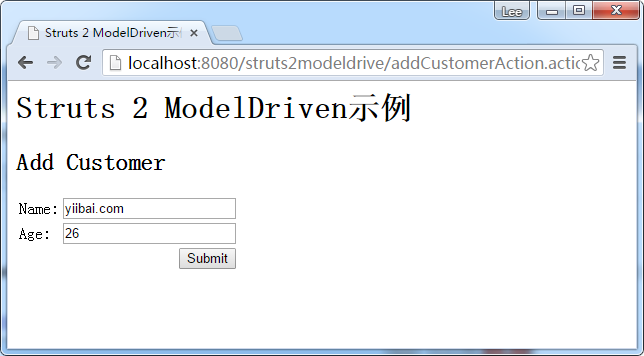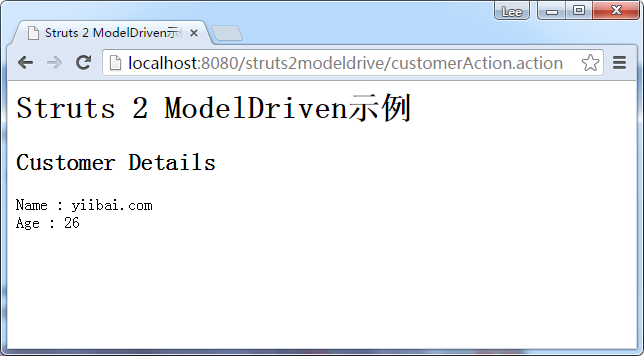Struts2模型驅動實例
這裏我們創建一個web工程爲:struts2-modeldrive ,用於講解演示Struts2模型驅動這一章內容的學習。
如果一個動作實現了「模型驅動」- ModelDriven 接口,它就獲得了表單數據自動傳輸到對象的額外能力。請參見下面的完整的例子:
1. 域對象
一個顧客(customer)對象,有 setter 和 getter 方法。
Customer.java
package com.yiibai.common;
public class Customer{
String name;
int age;
public String getName() {
return name;
}
public void setName(String name) {
this.name = name;
}
public int getAge() {
return age;
}
public void setAge(int age) {
this.age = age;
}}
2. 動作 - Action
Action類,實現了模型驅動ModelDriven 接口,聲明getModel()方法返回客戶的對象。當表單數據提交到這個動作,它會自動將表單數據傳輸到客戶的屬性。
客戶對象必須手動初始化。
CustomerAction.java
package com.yiibai.common.action;
import com.yiibai.common.Customer;
import com.opensymphony.xwork2.ActionSupport;
import com.opensymphony.xwork2.ModelDriven;
public class CustomerAction extends ActionSupport
implements ModelDriven{
//have to initialize it
Customer customer = new Customer();
public String execute() throws Exception {
return SUCCESS;
}
public Object getModel() {
return customer;
}}
3. JSP頁面
JSP頁面的模型驅動(ModelDriven)的示範。
addCustomer.jsp
<%@ taglib prefix="s" uri="/struts-tags" %>
Struts 2 ModelDriven example
Add Customer
success.jsp
<%@ taglib prefix="s" uri="/struts-tags" %>
Struts 2 ModelDriven example
Customer Details
Name :Age :
4. struts.xml
<package name="default" namespace="/" extends="struts-default">
<action name="addCustomerAction"
class="com.yiibai.common.action.CustomerAction" >
<result name="success">pages/addCustomer.jsp</result>
</action>
<action name="customerAction"
class="com.yiibai.common.action.CustomerAction" >
<result name="success">pages/success.jsp</result>
</action>
</package>5. 示例
訪問客戶表,填寫表格 (name : 「yiibai.com」, age 」 「26」) 並點擊提交按鈕,表單數據(name & age) 將自動轉移到客戶的屬性(name & age) (按屬性名稱匹配)。
http://localhost:8080/struts2-modeldrive/addCustomerAction.action

http://localhost:8080/struts2-modeldrive/customerAction.action

工程源代碼下載 - http://pan.baidu.com/s/1hqxyjf2